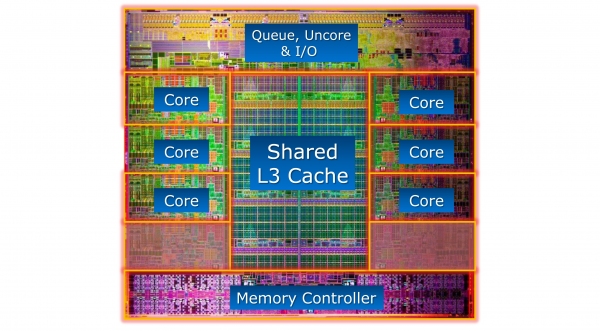
In this second part we will analyze in detail the performance of the Intel i7-3960X with Sandy Bridge-E architecture. Several tests will be run with various software, specific tests on the memory, CPU frequency, 3D and consumption scaling and overclocking. Very interesting are the comparison tests the Intel i7-980X.
Pubblicità
Pagina 22 di 22
Conclusions


| Performance | |
| Efficiency | |
| Overclock | |
| Price | |
| Overall |
As we saw in the first part of this article, you can not help but appreciate the excellent performance of this CPU, as indeed one would expect from a esacore based architecture Sandy Bridge. The LGA 2011 platform presents some very interesting aspects. The introduction of PCI Express 3.0 is definitely a great news, especially for the large number of lines present, which makes the platform suitable for high-level gaming systems, with the possibility of having up to 4 video cards with high bandwidth up to well 500MB/s (PCI-E 3.0 x8).Very good the operation of the Turbo Boost technology that allows the frequency increases up to 600 MHz for single-threaded applications, making the CPU very efficiently in even the older generation application, where the multi-core is not exploited.
Intel can still improve this CPU, the CPU Sandy Bridge-E integrates 8 cores already inside them, although two have been disabled. The position of advantage over the competition allowed it to not press the accelerator too much, giving up to many features of the x79 chipset to avoid potential errors such as happened with the bug of the P67.
Tests show without a shadow of doubt that this new processor is the current benchmark in desktop CPUs, although in some cases the gap with the architecture Gulftown is not so marked, but it is mostly caused by the failure to exploit this new architecture by the softwares. Very impressive computing power per core shared by all Sandy Bridge CPU architecture.
Analyzing the frequency scaling tests, the advantage of this SB-E platform is very marked. The results show a behavior more than linear with increasing frequency. Less obvious improvements derived from the use of RAM memory more or less driven. The scaling for the 3D stands at levels very similar to another Sandy Bridge CPU architecture, the i7-2600K.
Consumption measured by our instrumentation make this new processor in direct competition with the Bulldozer CPU AMD FX-8150: especially in overclocking, consumption of the two platforms are very similar, but of course for the Intel platform the performance advantages are very obvious and of leadership levels.
Even for the overclocking results we have obtained quite satisfactory results, although not markedly different, despite a greater flexibility in managing the clock, compared to Intel Sandy Bridge on socket 1155.
The price is undoubtedly high, we talk of a price in the order of € 900 including VAT, but Intel has always accustomed to high prices of its Extreme Edition CPU where those who want to buy it does not surely care at the price, but demands maximum performance as a reference. This CPU does accommodate these Enthusiast users. Will be very interesting to test the i7-3930K CPU which has a lower purchase price and the specifications are very similar. Stay tuned for these new tests!
Intel can still improve this CPU, the CPU Sandy Bridge-E integrates 8 cores already inside them, although two have been disabled. The position of advantage over the competition allowed it to not press the accelerator too much, giving up to many features of the x79 chipset to avoid potential errors such as happened with the bug of the P67.
Tests show without a shadow of doubt that this new processor is the current benchmark in desktop CPUs, although in some cases the gap with the architecture Gulftown is not so marked, but it is mostly caused by the failure to exploit this new architecture by the softwares. Very impressive computing power per core shared by all Sandy Bridge CPU architecture.
Analyzing the frequency scaling tests, the advantage of this SB-E platform is very marked. The results show a behavior more than linear with increasing frequency. Less obvious improvements derived from the use of RAM memory more or less driven. The scaling for the 3D stands at levels very similar to another Sandy Bridge CPU architecture, the i7-2600K.
Consumption measured by our instrumentation make this new processor in direct competition with the Bulldozer CPU AMD FX-8150: especially in overclocking, consumption of the two platforms are very similar, but of course for the Intel platform the performance advantages are very obvious and of leadership levels.
Even for the overclocking results we have obtained quite satisfactory results, although not markedly different, despite a greater flexibility in managing the clock, compared to Intel Sandy Bridge on socket 1155.
The price is undoubtedly high, we talk of a price in the order of € 900 including VAT, but Intel has always accustomed to high prices of its Extreme Edition CPU where those who want to buy it does not surely care at the price, but demands maximum performance as a reference. This CPU does accommodate these Enthusiast users. Will be very interesting to test the i7-3930K CPU which has a lower purchase price and the specifications are very similar. Stay tuned for these new tests!
Gianni Marotta
Valter D'Attoma
XtremeHardware Staff
Translated by Marco Comerci
Translated by Marco Comerci
- << Indietro
- Avanti

